Timeline of the James Webb Space Telescope
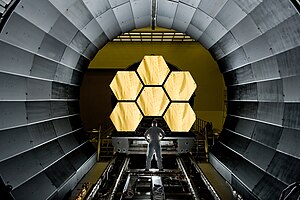
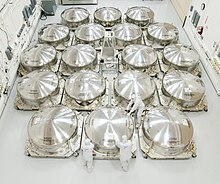
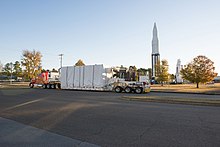
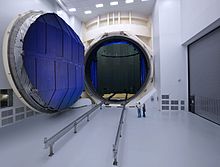
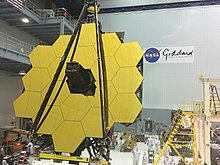
The James Webb Space Telescope is a planned international 21st century space observatory. It is intended to be a premier observatory of the 2020s, combining the largest mirror yet on a near-infrared space telescope with a suite of technologically advanced instruments from around the world.[1] JWST is expected to cost at least 8.8 billion dollars, including design, construction, and five years of operations (does not include extended mission funding) or International contributions.[2][3] Its likely peak year for funding was probably 2014, when the project used more than US$650 million.[2]
The Telescope is designed to last at least five and half years (six months calibration plus five years science operations), but with a goal of 10 years.[4] The limiting factor is expected to be fuel to maintain its halo orbit, of which there is enough for at least ten years.[4]
Timeline of selected events
- 1996, Next Generation Space Telescope initiated.[5]
- 2000, NEXUS cancelled (JWST technology demo).[6][7]
- 2002, $824.8 million prime contract for NGST awarded to TRW.[8]
- September 2002, NGST named James Webb Space Telescope.[5][1]
- January 2007, 9/10 technology development items pass non-advocate review.[9]
- April 2010, technical part of Mission Critical Design Review (MCDR) passes.[10]
- July 2011, James Webb project threatened with cancellation.[11][12][13][14]
- November 2011, JWST survives cancellation attempt.[15]
- 2012, MIRI instrument hand-off.[16]
- March 2013; FGS/NIRISS installed in ISIM.[17]
- July 4, 2013; MIRI installed in ISIM.[18]
- March 2014, NIRCam installed in ISIM [19]
- March 24–25, 2014, NIRSpec integrated into ISIM.[20]
- June 2014, first combined test of all four instruments including cryogenic testing in the Goddard Space Environment Simulator.[21]
- 2014, peak U.S. funding hit with US$650 million this year.[2]
- February 2015, hexagonal segments of the primary mirror completed.[22]
- December 2015, contract for JWST's launcher signed.[23]
- March 2016, cryogenic testing of instruments and mirrors completed.[24]
- March 3, 2016, secondary mirror installed on OTE.[25]
- March 2016, Aft Optics Subsystem installed on OTE.[26]
- November 2016, JWST construction completed (still needs testing, etc.)[27]
- January 2017, JWST is fine after experiencing an anomaly during vibration testing in Dec 2016.[28]
- March 27, 2018, JWST launch delayed to at least May 2020 as issues with the spacecraft element require further testing.[29]
- June 27, 2018, JWST launch postponed to March 30, 2021 based on recommendations by an Independent Review Board.[30]
Planned
- 2016, OTE tests complete.
- 2017, OTIS tests complete.
- 2017, Spacecraft (inc sunshield) tests complete.
- 2018, Observatory I&T complete.
- October 2018, planned launch as of 2016.[1]
- Early 2019, planned launch as of October 2017.[31]
- May 2020 or later, planned launch as of March 2018.[32]
- March 30, 2021, planned launch as of June 2018.[30]
After-launch plan
- After launch it is unfolded in the following planned order.[33]
- 1) spacecraft appendages (solar arrays, high gain antenna)
- 2) sunshield
- 3) extend tower
- 4) secondary mirror
- 5) primary mirror
- For 30 days after launch it takes a million mile trip to L2 halo orbit[34]
- For six months JWST is prepared for full-time science operation.[35] This includes letting everything cool down, calibrating the mirrors and instruments, etc.[35]
- Five year science mission starts after six months (planned)[35] (so five and a half years minimum planned)
- 10 years of operation goal, and enough fuel to maintain halo orbit for at least ten years is included.[4]
I&T schedule summary

After-launch deployment

Nearly a month after launch, a trajectory correction will be initiated to place the JWST into a halo orbit at L2.[37]
References
- ^ a b c "The James Webb Space Telescope". Explore James Webb Space Telescope. NASA. Retrieved 3 December 2016.
- ^ a b c Manufacturing Issues Plague James Webb Space Telescope. Nov 2014
- ^ Witze, Alexandra (2018-03-27). "NASA reveals major delay for $8-billion Hubble successor". Bibcode:2018Natur.556...11W. doi:10.1038/d41586-018-03863-5. Retrieved 2018-03-27.
- ^ a b c JWST FAQ
- ^ a b "About James Webb". NASA. Retrieved 15 March 2013.
- ^ "Nexus Space Telescope". MIT.
- ^ Multidisciplinary Analysis of the NEXUS Precursor Space Telescope
- ^ "TRW Selected as JWST Prime Contractor". STCI. 11 September 2003. Archived from the original on 5 August 2012. Retrieved 13 January 2012.
- ^ "JWST Passes NTAR". STScI. Archived from the original on 5 August 2012. Retrieved 5 July 2008.
- ^ "NASA's Webb Telescope Passes Key Mission Design Review Milestone". NASA. Retrieved 2 May 2010.
- ^ McKie, Robin (9 July 2011). "Nasa fights to save the James Webb space telescope from the axe". London: The Guardian.
- ^ "Appropriations Committee Releases the Fiscal Year 2012 Commerce, Justice, Science Appropriations". US House of representatives Committee on Appropriations. 6 July 2011.
- ^ "US lawmakers vote to kill Hubble successor". SpaceDaily. 7 July 2011.
- ^ "Proposed NASA Budget Bill Would Cancel Major Space Telescope". Space.com. 6 July 2011.
- ^ "NASA budget plan saves telescope, cuts space taxis". Reuters. 16 November 2011.
- ^ "Europe delivers first JWST instrument". sci.esa.int. Retrieved 2017-11-12.
- ^ [1]
- ^ [2]
- ^ [3]
- ^ "NIRSpec is integrated into ISIM". sci.esa.int. Retrieved 2017-11-12.
- ^ [4]
- ^ "NASA's James Webb Space Telescope Primary Mirror Fully Assembled". NASA.gov. 3 Feb 2016. Retrieved 4 Feb 2016.
- ^ [5]
- ^ Jenner, Lynn (2016-03-21). "NASA Marks Major Milestones for the James Webb Space Telescope". NASA. Retrieved 2017-11-12.
- ^ Jenner, Lynn (2016-03-07). "NASA's James Webb Space Telescope Secondary Mirror Installed". NASA. Retrieved 2017-11-12.
- ^ "GMS: JWST Aft-Optics System (AOS) Installed at GSFC". Retrieved 5 December 2016.
- ^ Nasa begins testing enormous space telescope made of gold mirrors
- ^ "No damage to JWST after vibration test anomaly - SpaceNews.com". SpaceNews.com. 2016-12-23. Retrieved 2017-11-12.
- ^ "James Webb Space Telescope, NASA's next Hubble, delayed again". CNET. 2018-03-27. Retrieved 2018-03-27.
- ^ a b "Jim Bridenstine on Twitter". Twitter. Retrieved 2018-06-28.
- ^ "JWST launch slips to early 2019 – Spaceflight Now". spaceflightnow.com. Retrieved 2017-11-12.
- ^ "NASA Delays Launch of James Webb Space Telescope Until 2020". Space.com. Retrieved 2018-03-27.
- ^ [6]
- ^ [7]
- ^ a b c http://jwst.nasa.gov/orbit.html
- ^ [8]
- ^ "James Webb Space Telescope - The First 30 Days After Launch". News Ledge. 2017-03-03. Retrieved 2017-05-30.


